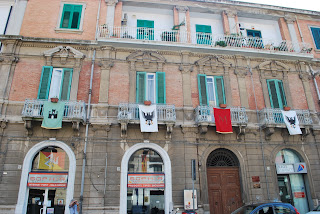
Before leaving the Palermo area let’s take a look at the famous cathedral of Monreale. It was the most beautiful church of our tour and is located just outside of Palermo.

It grew up in Norman times around a Benedictine monastery and became the favourite abode of Norman kings who liked hunting. The buildings are a mix of Medieval and Baroque. The cathedral is regarded as one to the finest expressions of Norman art and was built in the second half of the 12thC.

It’s strongest feature are the beautiful mosaics which cover the inside walls and Moorish influences. These mosaics are the work of Byzantine and Venetian craftsmen, executed between the end of the 12thC and the beginning of the 13thC. They depict scenes from the Old and New Testaments. The colours have remained vivid over the years as they are gold and ceramic rather than paintings which would have faded over the years. They are worth visiting.

The cloister is an example of Scicilian Romanesque sculpture almost in its original condition. It contains a fountain the shape of a stylised palm tree surrounded by a bud of 12 dancing figures. Twelve lion heads drop trickles of water into the basin, so soothing on a scorching day.

While we were in Monreale we witnessed a Sicilian wedding. The organ sounded and the bells rang out-good timing.
 We left Palermo and headed along the coast to Cefalu. Again, this town is really worth a visit. It’s one of the most beautiful and accessible. It faces the Tyrennkan sea overhung by a rocky outcrop.
We left Palermo and headed along the coast to Cefalu. Again, this town is really worth a visit. It’s one of the most beautiful and accessible. It faces the Tyrennkan sea overhung by a rocky outcrop.
It originates from prehistoric times and became a satellite of Rome in 3rdC BC. The cathedral shows many architectural styles including Arab influences, There are gold-ground mosaics and delicate cloisters.

It was so hot we went in search of hydration at an outdoor cafe where women were conspicuous by their absence. In fact this was often the case in towns, cafes. It seems the men sit around much of the day socialising, smoking and drinking while the women are home working, cooking, looking after children. This does not impress me, in fact it irritated me. You don’t see women congregating socially, enjoying the sun and air. It seems extremely backward to me, coming from my culture of equal opportunity. Most of the women on the streets were tourists.

We walked around some shops and I spied one which displayed beautiful ceramic pots and plates. I wanted to buy one but JC said it would break in the plane, even in hand luggage. I wish I hadn’t followed his advice as I never saw anything so beautiful or reasonably priced in the rest of my trip and went so home empty-handed. If you want reasonable quality ceramics stay away from the tourist clone shops and try to find something better. If you do, don’t muck about, buy it.

We moved on to Messina. I was interested to see this ancient port and assumed there would be lots of historical stuff to discover. I was wrong. The city lies in an area of high earthquake risk and has suffered many serious quakes. One in 1783 razed it to the ground and the catastrophic one of 1908 which was followed by a tidal wave almost wiped the city from the earth. There were 80,000 victims just in the city.
The Second World War mutilated the place further so what you see now is a modern but architecturally uninspiring city full of earthquake resistant buildings.
The cathedral (yes, yet another one) is rather unusual. It suffered severe damage in the bombing of 1943 and much of it has been rebuilt after the earthquake of 1908. It was consecrated in 1187 and has known many disasters such as fires, earthquakes and bombing. It has been rebuilt almost entirely.
 Of special interest is the belltower. At noon, all the animated figures of the campanile start moving in succession, creating representationsof the historical and religious life of the city. The belltower also indicates the phases of the moon, and a calendar. Nearby is the Fountain of Orion, built to commemorate the inauguration of an aquaduct.
Of special interest is the belltower. At noon, all the animated figures of the campanile start moving in succession, creating representationsof the historical and religious life of the city. The belltower also indicates the phases of the moon, and a calendar. Nearby is the Fountain of Orion, built to commemorate the inauguration of an aquaduct.






.jpg)






0 comments:
Post a Comment
I welcome your comments, contributions and feedback.